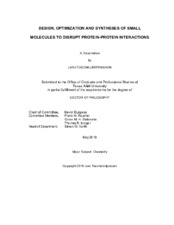Design, Optimization and Syntheses of Small Molecules to Disrupt Protein-Protein Interactions
Abstract
Protein-protein interactions (PPIs) are one of the basic mechanisms in cellular biology,
but also involve in diseases if they are dysregulation. Disrupting aberrant PPI activities
is useful in medicinal chemistry. One approach to inhibit PPIs is to design small
molecule peptidomimetics bearing side-chain orientations similar to protein ligands, in
which those mimics might displace or interfere the native PPIs. Previous research in our
group developed Exploring Key Orientations (EKO) program that matches Cɑ-Cß
coordinates of virtual small molecules to the side-chain vectors of proteins at PPI
interfaces. Similar Cɑ-Cß orientations between mimics and protein ligands indicate that
small molecules might be suitable to displace protein ligands, i.e. those compounds
might interfere PPIs.
We used EKO to deduce small molecules that might disrupt medicinally-relevant PPIs.
Herein, EKO implicated our designed mimics, hydantoin-oxazoline, triazole-oxazole and
triazole-oxazoline derivatives, might disrupt Nef•MHC-I•AP1 and NEDD8•NAE
interactions, in which they are relevant to HIV-1 and cancer diseases respectively. After
learning from these projects, we designed hydantoin-piperazine analogues to disrupt
PCSK9•LDLR interaction that causes hypercholesterolemia disease. Although the firstgeneration
hydantoin-piperazine derivatives did not show good PCSK9•LDLR inhibition,
we modified chemotype structures by cooperating with a docking program, Glide, to
improve inhibitory potencies. As a result, we successfully obtained lead compounds that
significantly disrupt PCSK9•LDLR interaction with the measurable binding affinities.
Besides these protein targets, we synthesized another minimalist mimic, oxazoline
piperidine-2,4-dione, that has conformational biases toward helical and sheet-turn-sheet
motifs. This structure potentially has favorable cellular- and oral-permeability calculated
by QikProp.
We are also interested in how to design molecules suitable for PPI inhibition. A concept
of secondary structure mimicry is widely applied to design molecules that resemble a
secondary structure at an PPI interface, hence possibly disrupt protein-protein
interaction. However, there is no direct study to prove a correlation between secondary
structure mimicry and interface mimicry. To respond this issue, we used EKO to match
several new chemotypes on the ideal secondary structures and PPIs database, and then
compared the frequencies of secondary structures that chemotypes matched at PPI
interfaces to the ideal secondary structure biases of each chemotype. We found that, in
general, good secondary structure mimics tend to match frequently at PPI interfaces;
however, they mostly match on non-ideal secondary structure motifs.
Citation
Taechalertpaisarn, Jaru (2018). Design, Optimization and Syntheses of Small Molecules to Disrupt Protein-Protein Interactions. Doctoral dissertation, Texas A & M University. Available electronically from https : / /hdl .handle .net /1969 .1 /173323.
Related items
Showing items related by title, author, creator and subject.
-
Moon, Soon Young (2012-05-04)Rotavirus (RV) causes more than 2 million diarrhea incidents and more than 600,000 deaths around the world every year. In order to prevent and treat this fatal disease, we must study, in depth, the mechanisms and pathogenesis ...
-
Zeng, Bin (2009-05-15)From opportunistic protist Cryptosporidium parvum we identified and functionally assayed a fatty acyl-CoA-binding protein (ACBP) gene. The CpACBP1 gene encodes a protein of 268 aa that is three times larger than typical ...
-
Quinlan, Robert Jason (Texas A&M University, 2005-02-17)Protein-ligand and protein-protein interactions are critical to cellular function. Most cellular metabolic and signal tranduction pathways are influenced by these interactions, consequently molecular level understanding ...


